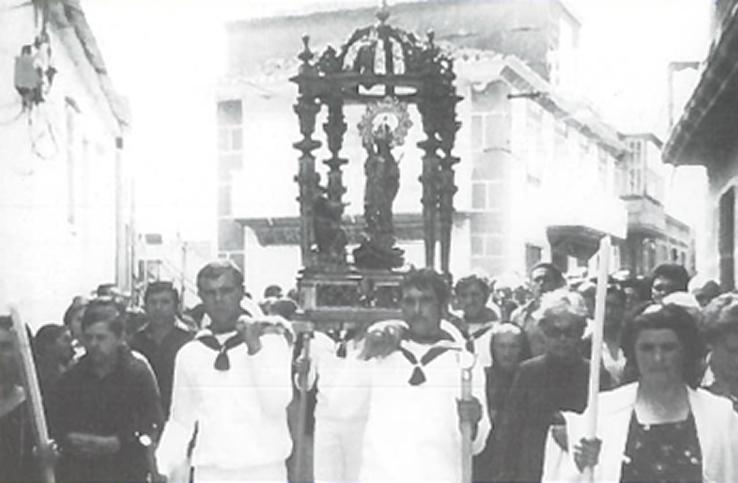Contemporary Era
The “Virgen de la Barca de Muxía” Festival that we know today is based on a rich history of devotion and popular celebration. The first written chronicles of this festival date back to the beginning of the 20th century, with a prominent mention in the local fortnightly El Eco de Mugía in 1903. Even then, the fervour towards the Virgin of A Barca attracted a heterogeneous multitude of pilgrims, as the newspaper described: “The deep-rooted, intense faith towards our divine Patroness attracts an enormous number of pilgrims of both sexes, of all classes and ages, forming a motley crowd that fills the arid paths and invades the town and the chapel.”
Throughout the 20th century, the “Virgen de la Barca” Festival continued to gain renown, attracting a growing number of visitors. Festive elements that still endure were incorporated, such as the endearing parade of giants and big-heads, dancing to the sound of traditional music and spreading joy as they pass by.
Deep Marian devotion is manifested in moving traditions, such as the arrival of pilgrims to the shrine, some even on their knees, seeking the Virgin’s protection and favour. The emblematic “Pedra de Abalar” rock, moved by the faith of the pilgrims, continues to be a meeting point and a tangible connection with the legend.
The big day of the festival is a spectacle of popular fervour. The solemn mass and the procession of the Virgin from the sanctuary to the parish church bring together a multitudinous human tide, testimony of a living faith handed down from generation to generation. On Monday, the local community accompanies the Virgin back, in an act of deep connection with their patron saint.
In 1932, the festival’s first official program was documented, revealing a growing organization and the consolidation of festive and religious elements. The fame of the “Virgen de la Barca de Muxía” Festival transcended Galicia’s borders, attracting the attention of the national media.
A momentous milestone was the Canonical Coronation of the Virgin in 1947, a recognition that further enhanced the festival’s prestige. In the following decades, the festival experienced a boom in parallel to the development of Muxía, incorporating new attractions such as the spectacular firecracker display, which added a touch of gunpowder and excitement to the festive nights.
The decade of the 80s marked a turning point with the incorporation of orchestras and the presence of renowned artists, consolidating the festival as a first-rate festive event. In 1989, the “Virgen de la Barca de Muxía” Festival attained a new level of recognition when it was declared a Festival of National Tourist Interest, a well-deserved award for its cultural richness and its crowd-pulling status.
The creation of the “Virxe da Barca de Muxía” Cultural Association in 1994 spurred even more ambitious festive programmes, attracting ever-larger crowds, including visitors from various countries, fascinated by the unique blend of faith, tradition and the imposing natural beauty that surrounds this event on the shores of the Atlantic. The “Virgen de la Barca de Muxía” Festival is still alive, vibrant and waiting to be discovered.
